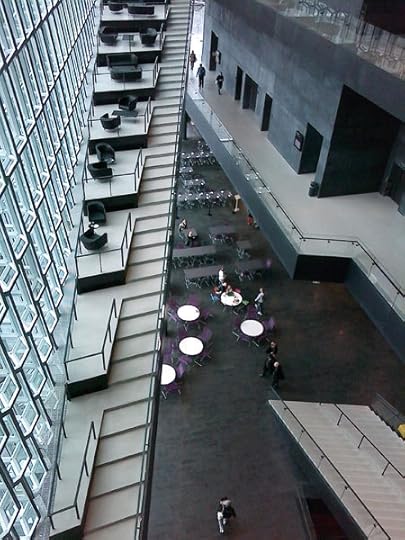Harpa Honeycomb
(for qB)
Because I've been spending more time lately in downtown Montreal, I've been thinking about contemporary architecture, a great love of mine -- and then a friend's post reminded me of honeycomb, and this building in Reykjavik that I visited just about exactly 6 months ago.
It's the city's new concert hall, named Harpa, built amid controversy over whether such an expenditure could be justified in the wake of Iceland's financial crisis. It was designed by the Danish firm Henning Larsen Architects and Icelandic architectural firm Batteríið Architects. Our friends there were not wild about the building itself, which sits on the wharf right at the edge of the ocean. As I went through my photographs I realized I didn't have any good pictures of the exterior -- I loved the different facades, but not the extra colors and LED lights which I felt detracted from the building's sculptural quality, especially at night -- but I was completely intrigued by the interior of the building, which I found both unusual and beautiful. The surfaces and lack of color -- all greys and black, except for an occasional touch of bright yellow or purple -- give it a restrained Scandinavian/Germanic ambience, quite different from most of what gets built in North America.
"The building's name Harpa refers to the musical instrument, the harp. It is also the name of the first month of spring in the Nordic calendar - and for the people of Iceland this means the promise of better times."
Steinunn Birna Ragnarsdóttir
Musical Director of Harpa
Most astonishing are the glass sides, constructed of steel and glass in a honeycomb-inspired design that seemed at first to be in a regular pattern, but revealed itself to have deliberate irregularities. I couldn't imagine how it had been designed and engineered, let alone built, and our friends told us that Asian construction workers had been hired to actually do the building work, because they were the only ones with experience in this type of construction. The descriptions of the building on the official website, unfortunately, don't include many details about how the design was developed and chosen, or how the engineering challenges were solved, though at the architect's own website, they say that in order to develop these ideas "the team worked with three-dimensional computer models, finite element modelling, various digital visualisation techniques as well as maquettes, models and mock-ups."
However, an article at arcspace.com provided some insight into the design itself. (The photos below are by Nic Lehoux, and Bára Kristinsdóttir respectively, from the gallery of press photos at the Harpa official website.)
The plaza in front of the Concert Hall is designed to generate a unique atmosphere where the dark base, referring to the black Icelandic sand, emphasizes the play of light and colors in the facades. The water pools mirror the facades and provide the plaza with a well-defined expression. Approaching the harbor from the city, the Concert Hall rises from the black base of the front plaza.
Harpa's multifaceted glass facades are the result of a unique collaboration between renowned artist Olafur Eliasson and Henning Larsen Architects. The design is based on a geometric principle, realized in two and three dimensions. Light and transparency are key elements.
Made of a twelve-sided space-filler of glass and steel called the "quasi brick," the building appears as a kaleidoscopic play of colors, reflected in the more than 1,000 quasi bricks composing the southern facade. The remaining facades and the roof are made of sectional representations of this geometric system, resulting in two-dimensional flat facades of five and six-sided structural frames. The crystalline structure, created by the geometric figures, captures and reflects the light – promoting the dialogue between the building, city and surrounding landscape.
We weren't able to enter any of the four concert halls, but they all look very beautiful. We did listen to a midday informal jazz concert in the cafe area (3rd picture above) along with many contented Reykjavik residents and visitors. Next time we'll be sure to book tickets to a concert; Harpa is the new home of the Icelandic Symphony, but presents events from theatre and opera to Bjork.
I only had my phone camera that day, but if you'd like to see more photos of the exterior and interior, here's a link to high-quality press photos of the building.







